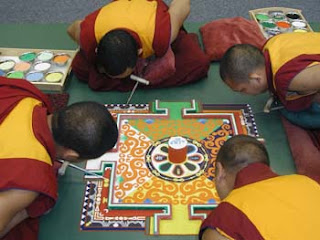Throughout various cultures and religions, the creation of art has been used in SO many unbelievably different ways to promote devotion to God, both in the artist and in the audience. For example, take stained glass windows. These are beautiful, ornate works of art intended to surround the worshipper and remind him or her of the narratives from Biblical scenes as well as to mimic the beauty and majesty of God. The focus on these works of art is less on the process of creation and more on the process of viewing the work as an outsider, and allowing the work to provoke thought within oneself.
In a slightly different way, eastern religions tend to focus on the act of creation as a meditative activity that should be used to promote focus on God and truth. Tibetan Buddhist monks perform the art of mandala, during which they create exquisitely detailed drawings with chalk. Upon completion of these drawings, the monks then blow the sand away to symbolize the fleeting nature of life, and to serve as a reminder of the folly of chasing after material pleasures.
Many artists have found the act of creation to be one of the most rewarding acts of worship. I myself view my sketchbook as my most valuable tool in meditation and prayer. When I flex my creative muscle, I allow God to speak through the gift and the passion he has given me for creation and appreciation of beauty. This is what fascinates me so much about art used in various forms of worship: our feeble human attempts to recreate the handiwork of the divine are what not only bring us to a place of meditation and worship, but also remind us of our place as finite beings in a world so much larger than we are. How's that for a philosophical thought? :)




No comments:
Post a Comment